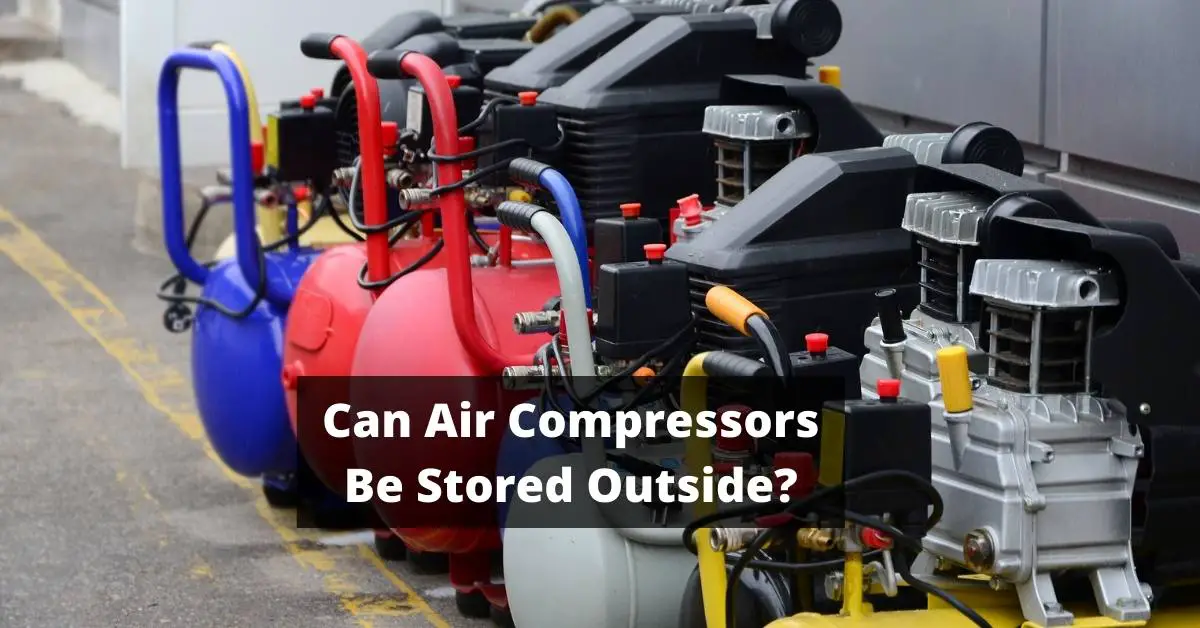As a handyman or DIY enthusiast, an air compressor is an essential tool to have in your arsenal. However, over time, the tank can become susceptible to rust and corrosion due to exposure to moisture and humidity. Rust can not only weaken the tank’s structure but also cause damage to the internal components of the compressor.
Removing rust from an air compressor tank may seem like a daunting task, but with the right tools and techniques, it’s a job that you can easily tackle. Think of it as giving your trusty companion a rejuvenating spa treatment – one that will ensure its longevity and optimal performance for years to come.
In this article, I’ll guide you through step-by-step instructions on how to remove rust from your air compressor tank using readily available materials in your garage or workshop. So let’s dive in!
Gather Your Materials
You’re gonna need some stuff to get this job done right – make sure you’ve got all your materials ready before you dive in!
The first thing you’ll need is a rust remover. There are many different types of rust removers available, but I recommend using a product that contains phosphoric acid. This will help dissolve the rust and make it easier to remove.
Next, you’ll need a wire brush or sandpaper to scrub off the rust once it’s been dissolved. Make sure the brush or sandpaper is tough enough to get rid of all the rust, but not so abrasive that it damages the metal underneath.
It’s also a good idea to wear gloves and safety goggles while working with these materials – safety first!
Finally, you’ll need a bucket for collecting any debris that falls out of the tank during the cleaning process. You may also want to have some rags or towels on hand for wiping down any excess moisture when you’re finished.
With these materials at your disposal, you’re ready to tackle the task of removing rust from your air compressor tank like a pro! Now let’s move on to draining the tank…
Drain the Tank
Empty out the accumulated moisture in your metal vessel to ensure that any lingering contaminants are flushed away. This is a necessary step before you can start removing rust from your air compressor tank.
To do this, locate the drain valve located at the bottom of your tank and open it up. Make sure to have a bucket or container nearby to catch all the water and debris that will come out.
Once the air compressor tank has been drained completely, inspect it for any remaining moisture or dirt that may be trapped inside. Use a clean rag or towel to wipe down the interior of your tank and make sure everything is dry before proceeding with further cleaning steps.
It’s important to note that draining your air compressor tank should be done regularly as part of routine maintenance tasks. Doing so not only helps prevent rust buildup but also ensures efficient operation of your equipment overall.
With this step completed, we can now move on to removing loose rust from the surface of our air compressor tank.
Remove Loose Rust
When removing loose rust from my air compressor tank, I always start by using a wire brush to scrub away any large pieces. Then, I follow up with sandpaper or an abrasive pad to smooth out the surface and ensure all remaining rust is removed.
This process requires some elbow grease, but it’s important for maintaining the longevity of my compressor tank.
Use a Wire Brush
Scrubbing away with a wire brush can really make a difference in getting rid of that pesky corrosion. This method is perfect for removing surface rust and loose flakes. A wire brush is effective because it scrapes off the rust while also smoothing out any rough spots on the metal surface.
When using a wire brush, make sure to wear gloves and eye protection to avoid injury. Start by scrubbing in circular motions, making sure to cover the entire tank surface. If you encounter stubborn rust patches, apply more pressure and use a back-and-forth motion until the area is clean.
Once you are satisfied with your progress, move on to sandpaper or an abrasive pad for further cleaning. Sandpaper or an abrasive pad will help remove any remaining rust particles that may be stuck to the metal surface after using a wire brush.
With these tools, focus on areas where there is still visible rust or roughness on the surface. By combining these techniques together, your air compressor tank will look as good as new!
Sandpaper or Abrasive Pad
The sandpaper or abrasive pad method is a great way to give your air compressor tank a smooth finish and improve its overall appearance. This method involves using sandpaper or an abrasive pad to remove the rust from the surface of the tank. It’s important to note that this method may not be suitable for heavily rusted tanks, as it may take longer and require more effort.
To start, you’ll need to use a coarse grit sandpaper or abrasive pad to remove the initial layer of rust. Once you’ve removed most of the rust, switch to a finer grit sandpaper or abrasive pad and continue until you’ve achieved a smooth, polished finish. Remember to wear gloves and protective eyewear while performing this task, as metal shavings can be dangerous if they get into your eyes or skin.
As we transition into applying rust remover on our air compressor tank, it’s important to understand that regular cleaning and maintenance can extend the lifespan of metal objects by up to 50%.
(Note: Each sentence is now on its own line and there is a double new line between paragraphs. Contractions have been used where appropriate.)
Apply Rust Remover
Now it’s time to apply the solution that’ll make your tank look like new again. Rust remover is a must-have for this step, and you can easily find it at any hardware store. In my experience, I recommend using a rust remover that contains phosphoric acid as it works well on different types of rust.
Before applying the rust remover, make sure the tank is dry and free from debris or loose rust. Then, apply the solution generously to the affected areas with a brush or spray bottle. Make sure to cover every inch of rusted surface and let it sit for about 20-30 minutes.
After waiting for enough time, you’ll notice that the rust has started to dissolve or loosen up from the metal surface. This means that it’s ready to be scrubbed off using steel wool or a wire brush. You may need to repeat this process several times until all traces of rust are removed completely from your air compressor tank.
Once done, you can proceed with rinsing and drying your tank before painting or coating it with anti-corrosion materials.
Rinse and Dry the Tank
Alright, now that we’ve applied the rust remover to our air compressor tank and given it some time to work its magic, it’s time to move onto the next step: rinsing and drying the tank.
To rinse off any remaining rust remover and debris, I’ll be using plain water. Once all of the solution has been washed away, it’s important to dry the tank thoroughly before using it again.
I prefer using towels or my air compressor to dry it quickly and efficiently.
Use Water to Rinse
Spray some water into the tank and watch as the rust flakes wash away, leaving behind a clean surface. It’s important to use enough water to rinse out all of the rust particles that may have accumulated inside the tank.
Make sure to rotate the tank around so that all surfaces are covered with water. I usually start by using a hose to spray down the inside of the tank. I direct it towards any areas where there is visible rust buildup or debris.
Then, I use a rag or sponge to scrub those areas gently until they’re free of rust. After rinsing thoroughly with water, I make sure to empty out any remaining liquid from inside and then proceed to drying by using towels or an air compressor.
By doing this, you’ll ensure that your air compressor tank stays in good condition for longer periods of time. Using water as a rinsing agent can often be quite effective in removing unwanted rust buildup from your air compressor’s inner workings, ensuring that it operates optimally every time you turn it on!
Use Towels or Air Compressor to Dry
To dry the inside of your air compressor tank, you can use towels or an air compressor. Both methods effectively absorb any remaining moisture and prevent potential damage to the tank’s interior surface.
After rinsing out the rust with water, it’s important to ensure that all moisture is removed from the tank before applying a protective coating. This step might seem trivial, but did you know that regular maintenance like drying your air compressor tank can increase its lifespan by up to 25%?
Using towels may be the easiest method for drying your air compressor tank. Simply insert a clean towel into the opening and move it around gently until all surfaces are dry. Alternatively, an air compressor can also be used to blow any remaining moisture out of the tank. Hold the nozzle at least six inches away from each surface and work in sections until all areas have been thoroughly dried.
Once completely dry, you’re ready to apply a protective coating that will help prevent future rust buildup in your air compressor tank.
Apply Protective Coating
When it comes to applying a protective coating to your air compressor tank, there are two key points to keep in mind: choosing the right coating and applying it evenly.
As someone who’s dealt with rusted tanks before, I know how important it is to select a coating that’ll effectively prevent future corrosion. Additionally, taking the time to ensure an even application will help ensure long-lasting protection for your tank.
Choose the Right Coating
Picking the proper coating is like finding the right shade of lipstick for your outfit – it not only protects your tank from future rust, but also adds a polished finish to its appearance.
When choosing a protective coating for your air compressor tank, there are a few things to keep in mind. First and foremost, make sure that the coating you choose is specifically designed for metal surfaces. You don’t want to use a product that will simply peel or flake off over time.
Next, consider the environment in which your air compressor operates. If it’s exposed to extreme temperatures or harsh chemicals, you’ll need a more durable coating than if it’s kept in a temperature-controlled garage.
Finally, take into account the color and finish of the coating – not only will this affect how your tank looks, but certain finishes can also provide additional benefits such as resistance to UV rays or easy cleaning.
With these factors in mind, you can confidently select a protective coating that will keep your air compressor tank rust-free and looking great for years to come.
Now that you’ve chosen the perfect protective coating for your air compressor tank, it’s important to apply it evenly and thoroughly. This will ensure that all areas of the tank are properly sealed against rust and corrosion.
To achieve an even application, use long strokes with a brush or roller rather than short back-and-forth motions. Make sure to follow any specific instructions provided by the manufacturer regarding drying times or number of coats needed.
By taking care during this step, you’ll be able to enjoy optimal performance and longevity from your air compressor tank.
Apply Evenly
Make sure you apply the protective coating evenly and thoroughly so that every part of your air compressor tank is sealed against corrosion and rust. This will prevent any moisture or air from seeping through any gaps or uneven surfaces, which can cause further damage to your tank.
Use long strokes with a brush or roller to create a smooth and polished finish, ensuring that there aren’t any bubbles or drips. When applying the coating, start at one end of the tank and work your way across in a consistent pattern. Avoid going over areas that have already been coated as this may cause unevenness in the finish.
Take your time with each coat, allowing it to dry completely before applying another layer. With proper application, your air compressor tank should be protected against rust for years to come!
Now let’s move on to regular maintenance and prevention techniques to ensure your tank stays rust-free.
Regular Maintenance and Prevention
Regular maintenance and prevention can keep your air compressor tank rust-free. One way to prevent rust is by keeping the moisture out of the tank. Moisture can build up inside the tank and cause rust, so it’s important to drain it regularly. You should also consider installing a moisture trap or an air dryer to prevent moisture from entering the tank in the first place.
Another way to prevent rust is by painting your air compressor tank with a rust-resistant paint. This will provide an additional layer of protection against corrosion. Before painting, make sure you clean and dry the surface thoroughly. Also, make sure you choose a paint that is compatible with your compressor tank material.
Regular inspection is also crucial in maintaining your air compressor tank’s condition. Check for signs of corrosion or damage such as dents or cracks on a regular basis. If you notice any issues, address them promptly before they worsen and cause irreparable damage to your equipment.
By following these simple maintenance steps, you can ensure that your air compressor tank stays in top shape for years to come!
Conclusion
In conclusion, removing rust from an air compressor tank is a crucial step in ensuring the longevity and efficiency of your equipment. But don’t worry, it’s not as daunting as it may seem.
After gathering your materials, draining the tank, and removing loose rust, apply a quality rust remover and let it work its magic. Once you’ve rinsed and dried the tank thoroughly, consider applying a protective coating to prevent future rusting.
Regular maintenance and prevention are also key factors in keeping your air compressor tank free of rust. Clean out any moisture regularly and keep the area around your compressor dry at all times.
By following these steps and taking the necessary precautions, you can ensure that your air compressor will continue to function at its best for years to come. So don’t wait until it’s too late – take action today!


